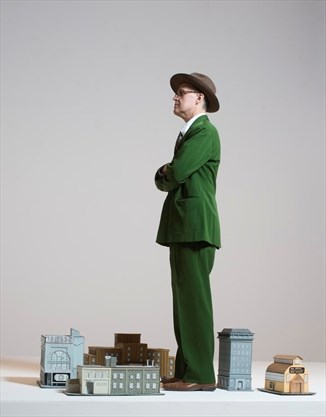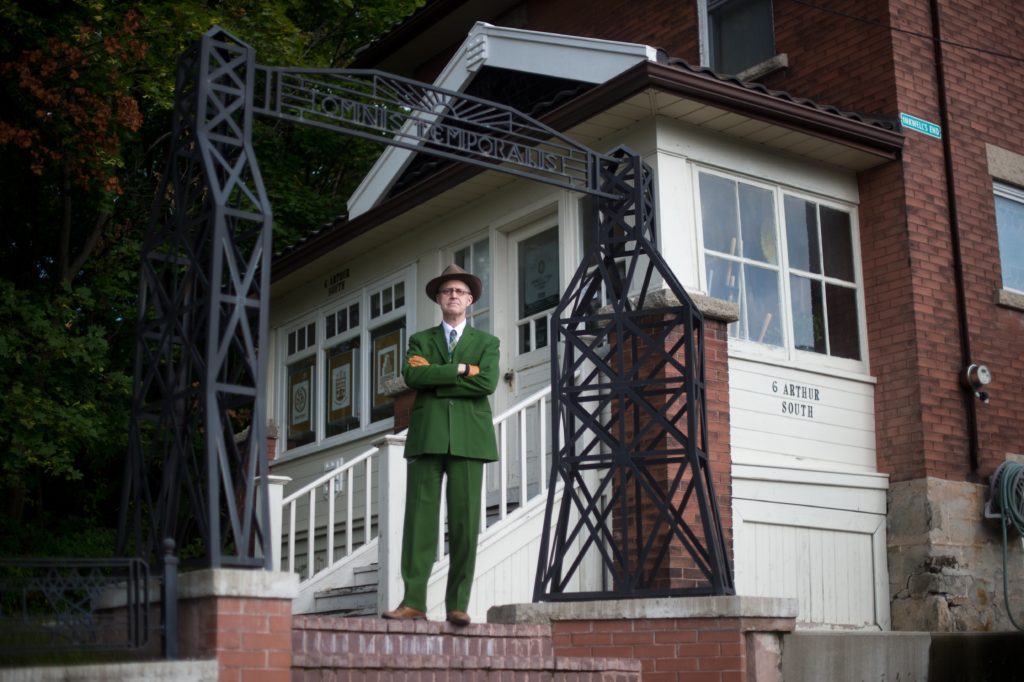By Joel Rubinoff
Photography by Mathew McCarthy
As I sit with the Guelph cartoonist known as Seth in his living room, a shadowy time portal stuffed with relics from another age, a train rumbles by so loudly the entire house seems to shake on its foundations.
“Does this happen often?” I ask, interrupting our talk about his life and career. “How do you stand it?”
The personable maverick — to indie graphic novelists what Madonna is to ’80s pop — shrugs without concern.
“A train is a human sound,” he tells me, as my coffee cup vibrates on a plump, leather coaster that looks at least five decades old. “I like it.”
Because the elevated railway line is historic and, therefore, not going anywhere, it’s an effective shield against the kind of mindless expansion that can drive a temporally rooted artist nuts.
“The minute that bridge goes down more (condo) towers will appear,” notes the author of a series of smart, incisive graphic novels that articulate the poignant regrets of mid-century losers with a melancholic affection for days gone by.
“That bridge is saving me.”
He’s a time traveller, this genial philosopher poet with a stake in the past, living in a red brick century home improbably christened like a ship — “Inkwell’s End” by name — with an archaic vending machine that dispenses souvenir pens for a dime on his porch.
Sobering and de-modernized, with an officious library room with etched lettering on its door, this methodically constructed Museum of Seth is also, in a surprising way, oddly cartoonish.
The bulbous 1940s refrigerator, the five-cent boomer gum machine, the ancient black dial phone with its sharp, curved handles — none is as colourful as the house’s exacting, lab-coated proprietor, who oversees the curation of a previous generation’s memories like a low-key Mr. Rogers.
“Nostalgia has been reduced to a commodity, a TV commercial,” insists the personable 57-year-old in his shuttered, slightly darkened living room. “I don’t want to be associated with that.
“Much of today’s culture is just lifestyle branding — selling people stuff. The past is perceived as a cool Tarantino movie.”
Seth’s work is about looking back, he admits, but not like some vapid Hollywood revisionist — he seeks nuance, complexity, critical insight.
Anyone who has read his latest opus, the 478-page “Clyde Fans,” can attest to the fact his interest in bygone eras is less whimsical than pungently bittersweet, more “Mad Men” than “Happy Days.” An ambitious 20-year project, “Clyde Fans” charts the disintegration of a mid-century family business and the brothers whose dysfunctional personalities perpetuate the loss.
It’s not pithy wisecracks that command his attention. It’s human emotion.
“The misconception that frustrates me is the idea that my art is an exercise in pure nostalgia,” he notes in his open, plain-speaking way. “That’s the one that forever hangs around my neck.
Rueful laugh: “That will be in my obit: ‘Nostalgia Artist Dies.’ ”
He’s an anarchic creationist nose-diving into the deep folds of history to unearth devastating truths that escaped scrutiny the first time around.
He’s also, by virtue of talent, intelligence and unwavering confidence, the coolest guy in the room — Marlon Brando with a sharpie and sketch pad.
“The past is a very nebulous place, but super powerful,” he notes, summing up the subtext of most of his work.
“It makes us who we are. It’s interesting because we can’t get at it.
“When people think back on their best memories, it’s inevitably sad — because those moments are gone. They don’t linger on in a concrete way — only as shadows. Memory is not a recording system like a VCR. It’s a murky world.”
He pauses, a firm set to his jaw: “I’m not writing about some idea of a golden past.

“My interest in the early 20th century is probably mostly about my parents and trying to understand my own life.”
Growing up in small town Ontario in the 1960s and ’70s, the inspired outlier was the youngest (by far) of five kids, born to an angry, distant father and a beleaguered, struggling mother, both of whom loved him as intensely as they disliked each other.
Clinton, Tilbury, Strathroy — anyone from a big city would be hard-pressed to find these places on a map. But they formed the cultural foundation for young Gregory Gallant, an ambitious loner who participated in school musicals and consumed culture through TV, the library and the newsstand while patiently awaiting his moment to shine.
“I was always one of those kids who would draw,” he recalls. “I was that kid.
“I wasn’t popular in high school, but I was ambitious. I didn’t feel crushed by the small town. I knew I was going to escape.”
When that moment arrived at the turn of the ’80s, he headed for Toronto, where he attended the Ontario College of Art (now OCAD University) and immersed himself in punk culture. With comic anarchists Joe Matt and Chester Brown, “The Toronto Three” reinvented the wheel for the next generation.
“I think walking around in a nutty costume with dyed hair and too much makeup was a good life lesson for me,” he notes of his wild-eyed emancipation.
“It taught me to be my own person, or at least to try to live life on my own terms.”
It was in this place, at this time, where he adopted his iconic nickname and — inspired by underground comic mentors such as Robert Crumb and above-ground ones such as Charles Schulz — established a reputation for thoughtful storytelling that touched a universal nerve.
“I was kind of scared of him when I met him,” recalls Brown, looking back almost 40 years.
“He was a total Goth. He had long white hair, his eyes were rimmed with red makeup and he had earrings and a nose ring.”
Brown laughs. “But once he started talking I realized he wasn’t scary at all. He was gregarious, funny and very talkative.”
Seth considers his early ’80s punk immersion pivotal in his maturation as an artist.
“It was the luckiest thing that ever happened to me,” he insists of his big-city makeover.
“The only time I felt genuinely in touch with the culture of the moment is when I was living in Toronto as a 20-year-old. Everybody was shiny silver and bright blue hair. It felt like living in the future.”
So, how did he end up in Guelph?
No big story: he was dating a Toronto woman and, because she had family in Guelph, they decided to move in 1999.
For a guy with worldwide stature and ambition to match, this smaller Canadian city proved a surprisingly good fit.
After his previous relationship broke up, he met his wife, Tania Van Spyk, put up his cartooning shingle — with sidelines as a book designer, papier-mâché puppet king and builder of tiny cardboard cities — and settled into a satisfying life as a quirky genius whose house gets rattled by trains five or six times a day.
“It took me 10 years to interact with the art community here,” he confides, at ease with his self-containment. “But I definitely feel like I’m a Guelph artist today.
“When I walk around town I don’t assume people know who I am. It’s probably more like ‘There’s that guy in the hat! — just another local eccentric.’ ”

That may be changing, with a mammoth mural adorning the wall of a downtown bookstore depicting key moments in the Life of Seth, and an Art Gallery of Guelph exhibition, “Seth: A Life, All Play.” The art gallery exhibit runs through Dec. 15 and showcases all aspects of his creative process.
But if he isn’t one to dwell on his accomplishments, which include five New Yorker magazine covers, an acclaimed comic book series (“Palookaville”), a National Film Board documentary about his life (“Seth’s Dominion”) and a string of industry awards, others are happy to pick up the slack.
“What Seth has done is take a style of cartooning language of the early 20th century and use it to tell stories that have not been told before and express emotions that have not been expressed,” notes friend and culture critic Jeet Heer, ranking Seth as one of the world’s top 15 cartoonists.
“Melancholy, regret and memories of the past — all the shades of psychology.”
He has also bridged the gap between high and low culture, insists Heer, championed a near forgotten strain of mid-20th century Canadiana spiked with Inuit igloos, Mounties and nature, and “in some ways moved beyond being mainly a cartoonist to being an artist.”
“Seth’s work speaks profoundly to the importance of stories,” adds Guelph gallery director Shauna McCabe.
“His unique graphic storytelling has shaped a global cultural imagination, populating it with unforgettable people and places — from George Sprott and Wimbledon Green to Palookaville and Dominion City.
“It also speaks to the significance of home. Although recognized internationally, much of the creative world tangible in his influential body of cartoons and graphic novels is informed by this place – Guelph – where he lives and works.”
Perhaps the most surprising thing about Seth, given his stoic, professorial attitude and self-imposed exile from modern pop culture, is that he’s not an introvert.
If anything, he’s an introverted extrovert, as I discover when he stands before more than 100 people at his gallery exhibition opening, professes love for his adopted city, then jokingly advises, “But don’t talk to me on the street.”
Or maybe he’s an extroverted introvert, tucked away in his basement bubble, ensconced in his art as evolution runs amok on the streets above.
“I’m an extrovert who values introversion,” he clarifies, eager to set the record straight.
“I’m very social but I deeply enjoy spending time alone. What I’m trying to do is create a private secluded world, like a sort of art project in itself. It’s not really for other people. It’s not like wearing a 1940s suit to get attention, but I’m not so stupid as to think I’m not seeking some kind of attention.”
He pauses, digging deeper. “I’m trying to figure out my reality. I’m not trying to live in the past. That’s impossible. Everything I’m doing, on some level, is built around the idea of creating my own image of an ideal life.”
“Clyde Fans,” which ping pongs through time, linking one tragic miscalculation to the next, is a master class in Seth’s brand of psychological deconstruction.

“I’m not interested in a plot or a big story,” he says of a book in which the two main characters spend their time roaming deserted buildings and streetscapes, ruminating about the past.
“I’m interested in the small details of life — little things, places, what it’s like to be alive.”
A generation ago, such existential sentiments may have been more suited to bulging novels by Kafka or Dostoyevsky.
But in 2019, graphic novels — thanks to artists such as Seth, Art Spiegelman and others — have long since outgrown their pulpy origins to hold their own in the cultural firmament.
“It’s a different world today,” notes the clear-eyed cultural observer.
“Everybody’s covered in tattoos. Everything is fragmented. The No. 1 movie genre for millennials is ‘horror.’ Are cartoonists on the wrong side of the divide? I worry that the medium will disappear. Every year I think ‘I made it through another year.’ ”
Regrets? He has a few.
He is convinced he should have followed his muse earlier, away from the suffocating small towns of his youth. “It would have opened my horizons,” he laments.
“I was too afraid. Now I’d be like, ‘The world is my oyster!’ ”
For the first time in our interview I sense genuine regret from this defiant nonconformist, who walks around in a zoot suit with pocket chain and fedora.
Is this regret justified? Probably not, but for a guy like Seth, the past will always be a snake pit of conflicting emotions.
“Making art is not entirely about catharsis or psychoanalysis,” he notes, filtering his own experience into something more universal. “But it’s part of it.”
He focuses intently, his look somewhere between resignation and acceptance.
“But just because you’re working through your issues,” he continues with impeccable Seth logic, “doesn’t mean that you solve them.”
With that, the man whose ability to extract large truths from tiny moments pauses with satisfaction.
Being conflicted, like the zoot suit and fedora, suits him well.
